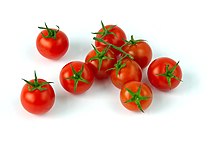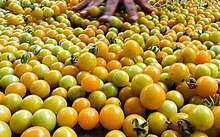Cherry tomato
| Cherry tomato | |
|---|---|

| |
| Scientific classification | |
| Kingdom: | |
| (unranked): | |
| (unranked): | |
| (unranked): | |
| Order: | |
| Family: | |
| Genus: | |
| Species: | |
| Variety: | cerasiforme
|
| Trinomial name | |
| Solanum lycopersicum var. cerasiforme | |
| Synonyms | |
|
Lycopersicon lycopersicum var. cerasiforme | |


The cherry tomato is a type of small round or plum-shaped tomato believed to be an intermediate genetic admixture between wild currant-type tomatoes and domesticated garden tomatoes.[2] Cherry tomatoes range in size from a thumbtip up to the size of a golf ball, and can range from spherical to slightly oblong in shape. Although usually red, other colours such as orange, yellow, green, purple, and black also exist.[3] Those shaped like an oblong share characteristics with plum tomatoes and are known as grape tomatoes. The cherry tomato is regarded as a botanical variety of the cultivated berry, Solanum lycopersicum var. cerasiforme.[4]
History[edit]
"The cherry tomato... is believed to be the direct ancestor of modern cultivated tomatoes and is the only wild tomato found outside South America."[5] The tomato is thought to have been first domesticated in the Puebla-Veracruz area of Mexico and to have reached this area from South America in the form of a weedy cherry tomato.[5]
The first direct reference to the cherry tomato appears in 1623, in a work called Pinax theatri botanici (English: Illustrated exposition of plants) by Swiss botanist Caspar Bauhin, which contains descriptions and classifications of approximately six thousand species. In a section on "Solanum" (nightshades), Bauhin wrote of a variety called Solanum racemosum cerasoru[m] forma, which translates to "Solanum [that is] full of clusters [racemosum], in the form (shape) of cherries".[6]
Cherry tomatoes have been popular in the United States since at least 1919.[7] Recipes using cherry tomatoes can be found in articles dating back to 1967.[8]
Cultivars[edit]
The Super Sweet 100 is a hybrid cultivar popular in the United States and resistant to both Fusarium and Verticillium wilt.
The Selke Biodynamic cherry tomato is named after Margrit Selke.[9]
The indeterminate hybrid sungold cherry tomato is known for its vigorous early-yielding plants and colorful orange fruits.
The Tomaccio tomato was developed by Nahum Kedar and Chaim Rabinovitch of the Agriculture Facility of the Hebrew University of Jerusalem on its Rehovot Campus, Israel. It is the result of a 12-year breeding program using wild Peruvian tomato species to create a sweet snack tomato with improved ripening time and shelf life.[10][11]
Nutrition[edit]
| Nutritional value per 100 g (3.5 oz) | |
|---|---|
| Energy | 76 kJ (18 kcal) |
5.2 g | |
| Sugars | 3.5 g |
| Dietary fiber | 1.7 g |
0 g | |
0.9 g | |
| Vitamins | Quantity %DV† |
| Vitamin A equiv. | 5% 42 μg2% 250 μg |
| Thiamine (B1) | 0% 0 mg |
| Riboflavin (B2) | 0% 0 mg |
| Niacin (B3) | 1% 0.17 mg |
| Pantothenic acid (B5) | 0% 0 mg |
| Vitamin B6 | 1% 0.02 mg |
| Folate (B9) | 4% 14 μg |
| Vitamin C | 29% 26 mg |
| Vitamin E | 1% 0.2 mg |
| Minerals | Quantity %DV† |
| Calcium | 1% 14 mg |
| Iron | 4% 0.63 mg |
| Magnesium | 3% 14 mg |
| Manganese | 5% 0.12 mg |
| Phosphorus | 3% 33 mg |
| Potassium | 9% 260 mg |
| Sodium | 0% 6 mg |
| Zinc | 1% 0.16 mg |
| Other constituents | Quantity |
| Water | 92.2 g |
| †Percentages estimated using US recommendations for adults,[12] except for potassium, which is estimated based on expert recommendation from the National Academies.[13] | |
References[edit]
- ^ "Garden Tomato Synonyms (Solanum lycopersicum var. cerasiforme as Classified by NCBI Taxonomy) - Encyclopedia of Life". Eol.org. 29 July 2014. Retrieved 22 August 2014.
- ^ Nesbitt, TC; Tanksley, SD (2002). "Comparative sequencing in the genus Lycopersicon. Implications for the evolution of fruit size in the domestication of cultivated tomatoes". Genetics. 162 (1): 365–79. doi:10.1093/genetics/162.1.365. PMC 1462239. PMID 12242247.
- ^ "BBC - Food - Cherry tomatoes recipes". Retrieved 24 October 2014.
- ^ "Lycopersicon esculentum var. cerasiforme, nomen.at". Nomen.at. Retrieved 24 October 2014.
- ^ a b Kiple, Kenneth F., ed. (2000). The Cambridge World History of Food. Vol. 1. p. 352. ISBN 9780521402149.
- ^ Wexler, Anna (2016). "Seeding Controversy: Did Israel Invent the Cherry Tomato?" (PDF). Gastronomica. 16 (1): 1–11. doi:10.1525/gfc.2016.16.2.1.
- ^ "The Saskatoon Phoenix - Google News Archive Search". Retrieved 24 October 2014.
- ^ "The Milwaukee Journal - Google News Archive Search". News.google.com. Retrieved 24 October 2014.[permanent dead link]
- ^ "McKean County Biodynamics featuring Master Gardener L. A. Rotheraine". Rotheraine.com. Retrieved 22 August 2014.
- ^ "Tomato 'Tomaccio'". Raker.com. Retrieved 24 October 2014.
- ^ "Tomaccio Sweet Raisin Tomatoes". Tomaccio.com. Archived from the original on 1 October 2014. Retrieved 22 August 2014.
- ^ United States Food and Drug Administration (2024). "Daily Value on the Nutrition and Supplement Facts Labels". Retrieved 28 March 2024.
- ^ National Academies of Sciences, Engineering, and Medicine; Health and Medicine Division; Food and Nutrition Board; Committee to Review the Dietary Reference Intakes for Sodium and Potassium (2019). Oria, Maria; Harrison, Meghan; Stallings, Virginia A. (eds.). Dietary Reference Intakes for Sodium and Potassium. The National Academies Collection: Reports funded by National Institutes of Health. Washington (DC): National Academies Press (US). ISBN 978-0-309-48834-1. PMID 30844154.
{{cite book}}: CS1 maint: multiple names: authors list (link)
External links[edit]
![]() Media related to Solanum lycopersicum var. cerasiforme at Wikimedia Commons
Media related to Solanum lycopersicum var. cerasiforme at Wikimedia Commons
